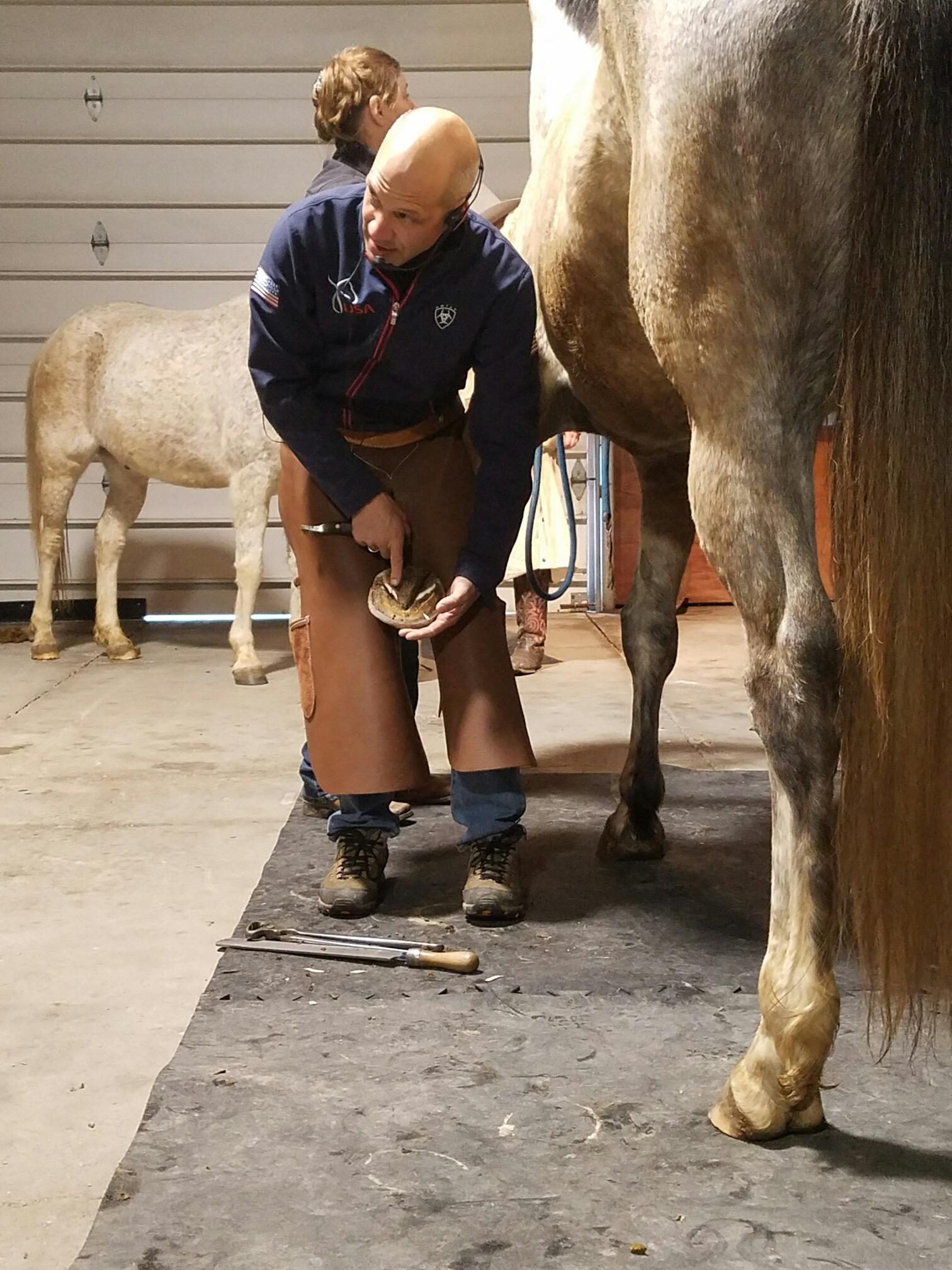 Equine veterinarian and farrier Todd Meister discussed the importance of evaluating the whole horse before coming up with a trimming and shoeing protocol at the Ken Davis & Sons open house and clinic March 18 in Richwood, Ohio.
Equine veterinarian and farrier Todd Meister discussed the importance of evaluating the whole horse before coming up with a trimming and shoeing protocol at the Ken Davis & Sons open house and clinic March 18 in Richwood, Ohio.
Meister, who is a member of Chester County Farrier Service in Unionville, Pa., as well as the United States Equestrian Team since 2003, kicked off the clinic with a discussion on trimming.
When looking at a foot, Meister tries to identify common themes. He looks at the back half of the foot and finds the end of the true bar (located even with the widest point of the foot) and then identifies the true point of the frog (where the frog contacts the sole).
Meister then proceeds to rasp the heels first, taking it to the widest part of the frog. Once the back of the foot is defined, then the toe can be established. If necessary, he will relieve the quarters then finish by smoothing the edges. He does very minimal dressing of the hoof wall. The Olympic shoer believes that if you really look at the foot, it will tell you what needs to be done.
When he finished his presentation, Meister had a couple clinic attendees trim a horse and a pony while he instructed. He pointed out on one of the equines the black lines that show up in the quarters, explaining that this shows excessive pressure on the part of the foot and that those areas should be unloaded.
When the attendees finished trimming their horse and pony, Meister proceeded to state why he feels horses are the best teachers — better than people. It’s because — they don’t lie and they don’t have an ego. He concluded the morning’s session by stating that farriers always should be willing to try new things. You never know what might work with a particular horse.
Meister presented another lecture after lunch in which he focused on posture.
His definition of posture for the horse is: “Posture = Position of the horse’s limbs in relationship to its spine and the ground. Good posture for a horse equals a relaxed back.”
Meister also feels that how a horse stands is how it moves. Using the rhyme, “Round is Sound,” he states that if it shows a relaxed back, it is a comfortable horse. For a tangible example to help lead into further discussion of this topic, the clinician had everyone stand up straight. He asked that we place our hand on the closest muscle on our spine and slowly lean forward and return to a neutral position. We were asked to note the tension that was created in our backs when our base of support was no longer in the proper position. He stated it was no different for the horse and that correct trimming and shoeing will help correct posture in the equine.
Going back to the projector screen, Meister displayed many cases — with before and after pictures — that demonstrated how correct trimming and shoe placement can improve posture and make the horse more comfortable. He stated that as he photographed horses for this lecture, even he was surprised at how subtle changes could significantly affect the posture.
Throughout the presentation, he continued to stress the importance of not getting too caught up in the feet — look at the horse’s whole body. Meister uses his dividers, measuring the true end of the bar and the true point of the frog as landmarks to help determine the placement of the shoe. He is looking for a 1-to-1 ratio around the center of rotation of the coffin joint.
Meister moved on to discuss the benefits and how he uses pour-in pads, particularly products from Vettec, which sponsored the clinic.
He shared a test that he uses to determine whether a horse might benefit from the pour-in pad product before using it. Meister will pack a horse’s feet with bedding, then have the handler jog the horse for him to evaluate. Then, he will pick out the packed bedding and have the horse jogged again. If he can see that the horse was noticeably more comfortable with the bedding, then he will use the product on that horse.
Meister performed a live horse demonstration in which he showed how he evaluates the horse from top to bottom before picking up a foot, reinforcing the importance of taking the whole horse in consideration. He considers their conformation and what the horse does for a living before coming up with a trimming and shoeing protocol.
Meister proceeded with trimming the hooves, selecting the shoe style and appropriate size then shaping the shoes. While shaping the shoes, he pointed out that since the horse was a trial horse, he was going to be more conservative on his fit. He fit it a bit tighter, with less room for expansion at the heels than he would typically leave on his upper level show horse that he works on in his practice. He emphasized that when going on a trail ride that may last several miles or all day, the last thing the rider needs is the horse pulling a shoe half way through.
After finishing the live shoeing, Todd answered questions form the audience and wrapped up the day by telling attendees to “Go Home and Look Up” — look above the hoof to get some feedback.







Post a comment
Report Abusive Comment